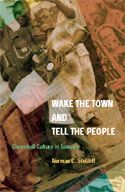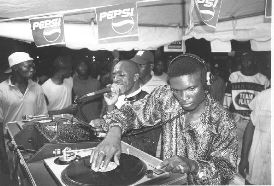
Until quite recently, reggae was largely undocumented. In Jamaica,
the need has not generally been felt for written documentation;
the music is simply there to be made by the artists or enjoyed
by its fans. The music is left to speak for itself. Outside Jamaica,
or outside the diaspora of Jamaican communities, the music was
either ignored or scorned, considered unworthy of such critical
attention. During the last decade, books like Reggae: the Rough
Guide have taken great strides towards redressing this injustice
but there is still a long way to go before reggae can enjoy the
kind of critical respect in print that other musics can take for
granted.
If little has been written about reggae music, less still has been written about dancehall. There are still too many who believe that reggae died with Bob Marley and swiftly degenerated into a nightmare of guns, homophobia, misogyny and tinny Casios. It is often forgotten that the digital revolution took place in Jamaica fifteen years ago and that dancehall has in fact been around longer than ska, than rocksteady, and even than roots reggae itself.
Norman Stolzoff takes this further still, more than two centuries further, to be precise. For him, all Jamaican popular music has its roots in the dancehall which can be traced back to the earliest days of slavery. In his opening sections he draws on some fascinating source documents to show that: "Every dance was seen as an occasion for a potential mob, as a potential catalyst of riot and disorder- another feature of dancehall's reception by the middle and upper classes that has remained to this day." He makes the point well that the fear, ridicule and contempt heaped on dancehall by its opponents has been suffered by Jamaican music from its very inception.
If Stolzoff's long view of Jamaican history and its roots in slavery and colonial injustice is one of the strengths of his book, then so too is his attention to detail. The next section of his book, tracing the development of Jamaican music from the 1940's through to the 1970's is the most detailed I have yet read. It draws heavily on the oral testimony of elder statesmen of Jamaican music such as Hedley Jones, former president of the Jamaican Federation of Musicians, Winston Blake, operator of the Merritone sound system for more than forty years, and Bunny Goodison, operator of the Soul Shack sound system since the 1960's. Between them these men tell the enthralling story of how Jamaican music developed through urban Kingston's rapid growth in the 1930's, the wandering street singers and dance bands of the 40's, the rise of the sound systems in the 50's, the growth of an indigenous recording industry and the post-independence emergence of ska, the first wholly indigenous Jamaican music. While this story has been sketched out before, notably in Barrow and Dalton's Rough Guide to Reggae, never before has it been explored so thoroughly.
This is a book crammed with fascinating incident. Here is an anecdote from Winston Blake which illustrates the epic rivalry between Duke Reid and Coxsone Dodd in the 1950's. Both men were making trips to the States to procure records that no one else had, renaming them as their own and keeping their true identities secret:
"Coxsone had two records were his clear records: one called "Sweepstakes" which the real name of it was "Got Good News For You, Baby" by a guy named John Perry. So Duke Reid made a trip and then the rumour go out, you know, them phone up and say they find two of Coxsone's record. so they were having a special dance Monday night and they bust the two record them. So crowds come from everywhere. Coxsone's fans, Duke Reid fans, And the dance ram. And about midnight, the [Reid's] man would just say well: "We have here on a RCA label serial no. 553344 'San Diego Bounce' by Harold Land, which you know by 'Downbeat Shuffle' You ready for this?" And the crowd say: "Yeah!" And from they hear it and identify it , the whole place just break up in pure mayhem, man. It's like what you would call a pram-pram [imitating gunshots] now, it's pure noise and jumping and shouting and jubilation. Then Coxsone would go up and try bust two of Duke Reid's record. A lot of that used to happen."
For many however, the most important section of the book will
be Stolzoff's account of dancehall as it is happening now, or
was five years ago when he spent twelve months in Kingston doing
field work for his doctorate at the University of California.
Those who find the notion of an academic study of dancehall rather
ludicrous should be aware that those in the Jamaican dancehall
business clearly did not. During that time Stolzoff talked to
an impressive roll call of those in the business, hooking up in
particular with the Killamanjaro sound crew, an account of whose
work forms some of the most enthralling chapters of his book.
Primarily, Stolzoff sees dancehall as an industry, an economic
activity which reflects and expresses the realities of the society
in which it has to operate. His starting point is not the sound
of the music itself and his own responses to it. This again might
seem perverse to many but Stolzoff's uncompromising materialist
approach reveals more about the Jamaican dancehall than any number
of well meaning emotional responses to the power of the music.
Stolzoff's approach is effective because Jamaican music is a particularly bottom-up, grassroots affair. For every Jamaican artist who breaks it internationally, there are two thousand more struggling young hopefuls. Stolzoff looks for the truth about dancehall in the lives of these "no-name" artists and in those uncelebrated dances that take place all over the island every night of the week. He writes at length about just such a group of aspiring DJs who he befriended and came to know well, the White Hall Crew who day after day hung out outside the Dub Store recording studio in Kingston waiting for a "bly", the chance to go in and voice the tune that might kickstart their career and propel them out of the ghetto and on to international fame and fortune. Stolzoff finds the truth about dancehall in their day to day hustlings and scufflings, the economic misery and deprivation that drives them on, and the strong work ethic which sustains them, rather than the atypical career paths of the few who make it. Their oral testimony is for me the backbone of the book.
Again, the strength of Stolzoff's approach is that he comes to Jamaican music without preconceptions. An excellent listener with an eye for the telling detail, he sees what is actually there and not, like others, a myth that he came to find. While he does not shirk the vexed issues of homophobia, misogyny and glorification of violence, he shows with great clarity how the music does not cause the social ills of its society but expresses them, in ways that are often complex and contradictory. In a society with few economic opportunities, dance hall is a business, an intensely competitive career path with an intensely strong work ethic and a DJ's lyrics will often owe more to a shrewd professional understanding of his audience than a deeply held set of convictions. As Beenie Man puts it: "I DJ little gun, me DJ a little girl, me DJ a little reality, me DJ history. So you just mix to the crowd. And just give the crowd a good show. Cause that's what dem want to hear. So it go."
As comprehensive an account of Jamaican music as has yet been written, Wake The Town stretches from slavery days to a Stone Love vs. Kilamanjaro sound clash. On the other hand, Stolzoff's eye for the small detail guides his reader through the minutiae of Kingston's political wars and garrison constituencies, the decline of the live DJ and the rise of the dub plate. You want to know about the economics of cutting a dub plate? The ritual of clearing the lawn before a big dance? The practical detail of running a sound system and how much the people in the business actually earn? Then this is your book.
Stolzoff begins and ends his book with descriptions of the intensity of a dancehall clash, as if to remind us that for all the dispassionate skills of his analysis, words have their limits and this is a story that begins and ends in the raw power of great music. Probably the best book yet written about reggae, this will be the benchmark against which future books on Jamaican music must measure themselves.
Copyright, Geoff Parker, March 2000